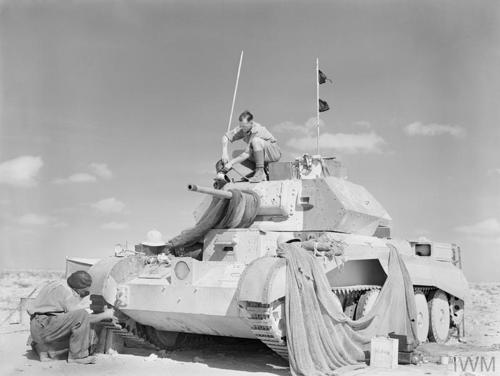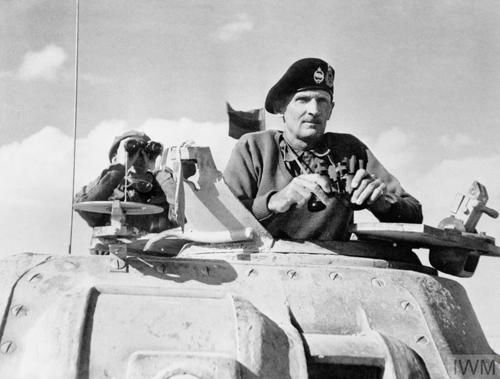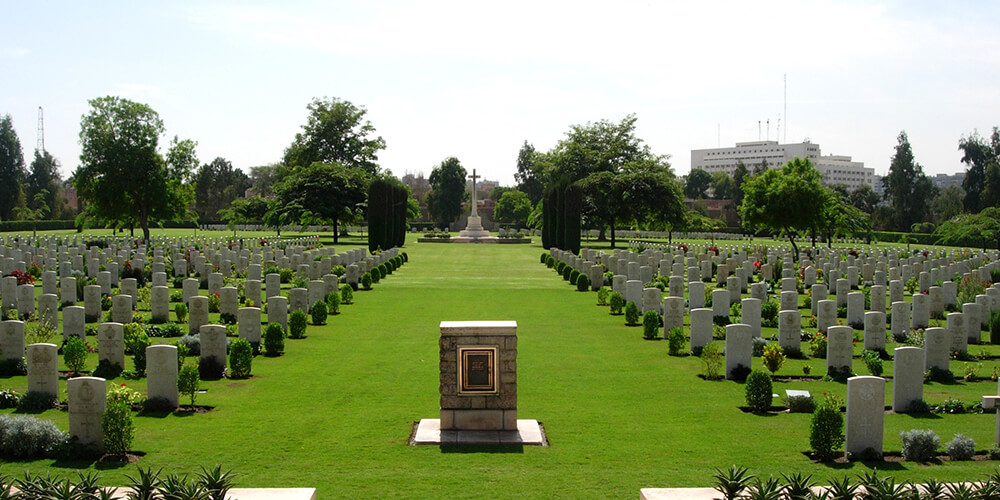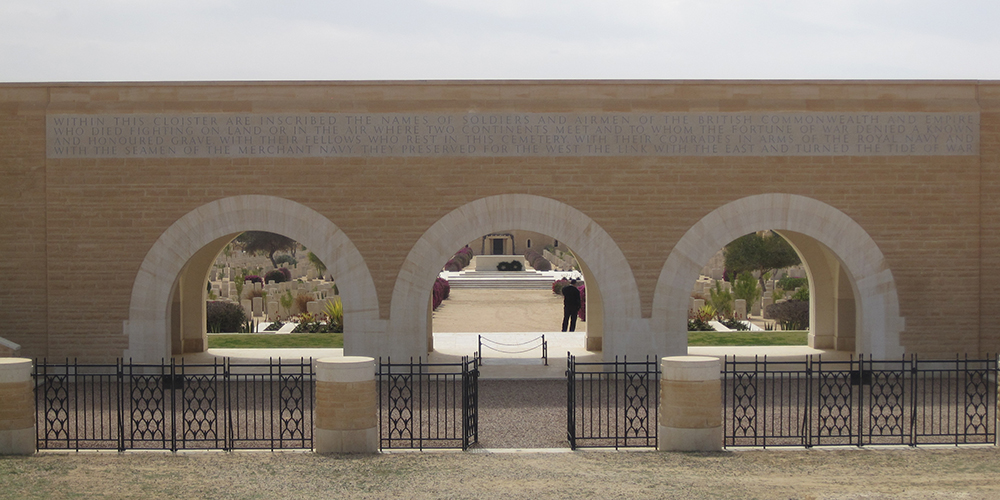17 March 2023
Egypt in WW2 - history, significance and commemoration
From the Pharaohs, Saladin and Napoleon, Egypt has a rich and complex history. In the 20th Century, it would once again play a key role as war ravaged the deserts of North Africa. Discover more about Egypt in WW2 and about our role there today.

Was Egypt an ally in WW2?
The history of Egypt and the United Kingdom is long and complex. The two nations have been entwined for centuries, although relations have been, at times, far from cordial.
For much of World War Two, Egypt remained officially neutral, however due to terms agreed in the Anglo-Egyptian treaty of 1936, at the outbreak of war British troops were already stationed in Egypt in order to protect the Suez Canal Zone.
What was Egypt’s role in WW2?
While nominally neutral for the majority of the war, the Egyptian armed forces did see limited action during the conflict.
Under the terms of the treaty of 1936, Egypt was obliged to provide logistical support to British forces in Egypt, and Egyptian anti-aircraft batteries were used to defend the cities of Cairo and Alexandria from bombing raids by the German and Italian air forces.
In the main, Egyptian troops did not play a major part on the frontlines in the desert but continued to provide logistical support throughout the conflict.
Egypt would formally declare war on Germany and Japan in February 1945, as the war entered its final months.
Why was Egypt important in WW2?
 Part of Egypt’s strategic value came from the Suez Canal, a vital waterway that links the Mediterranean Sea with the Indian Ocean. Control of the canal meant that the Allies could dramatically shorten the sea voyage between Europe and parts of Africa & Asia, avoiding the treacherous seas on the long trip around Africa.
Part of Egypt’s strategic value came from the Suez Canal, a vital waterway that links the Mediterranean Sea with the Indian Ocean. Control of the canal meant that the Allies could dramatically shorten the sea voyage between Europe and parts of Africa & Asia, avoiding the treacherous seas on the long trip around Africa.
Egypt was also a vital hub for the export of oil from British controlled parts of the Middle East. During World War Two the huge fleets of warships, countless squadrons of aircraft and vast armies of vehicles and tanks of the combatant forces meant that the control and distribution of oil was of tantamount importance to the war effort.
German and Italian forces came to control large portions of North Africa, including much of the Libyan and Tunisian coastline. In Egypt, Commonwealth forces managed to stop the Axis conquest of Northern Africa, turning the tide of the battle, and using it as a launch pad to recapture the coast and the important ports that were used in the later invasion of Sicily.
Image: HMS HOWE closing an Egyptian felucca during passage of the Suez canal. © IWM (A 24896)
What happened in Egypt during WWII?
The Suez Canal ensured that Egypt would remain vital throughout the war, but no more so than when war raged in the Western Desert between 1940 and 1943.

El Alamein 1942: British tanks move up to the battle to engage the German armour after the infantry had cleared gaps in the enemy minefield. © IWM (E 18481)
Was Egypt invaded in WW2?
Italian forces invaded Egypt in June 1940. Advancing along the coast from bases Libya, the Italians hoped to drive the British from Egypt and capture the Suez Canal securing the eastern entrance to the Mediterranean Sea.
Their initial advance was cut short however at Sidi Barrani where British forces began a counterattack that would see them drive the Italians back into Libya and capture the strategically important port of Tobruk.
The arrival of German forces in February 1941 in North Africa shifted the balance of power in the Western Desert back in favour of the Axis. The German Afrika Korps under Erwin Rommel recaptured Tobruk eventually advancing from Libya and back into Egypt, advancing as far as El Alamein, just 150 miles/240 km shy of Cairo.
British regiments in Egypt WW2
 The Allies’ main force in Egypt in World War Two was the British 8th Army.
The Allies’ main force in Egypt in World War Two was the British 8th Army.
It was formed from the then Western Desert Force in 1941 and comprised the 7th British Armoured Division and the 4th Indian Infantry Division. As more and more resources were dedicated to the war in the desert, the 8th Army expanded to 10 divisions.
By the time of the Second Battle of Alamein, the 8th Army was under the leadership of Lieutenant-General Bernard Montgomery, and included men of many nations, including from Australia, India, New Zealand, South Africa and the United Kingdom but also Free French, Greek, Polish, and Jewish units from British Mandated Palestine.
Image: A13 Cruiser Mk IVA tank being checked over shortly after arrival in Egypt, 1 November 1940. © IWM (E 1004)
What happened in Cairo during WW2?
In November 1943, Cairo was host to a conference between three of the major Allied powers of World War Two: Franklin D Roosevelt, Winston Churchill and Chiang Kai-shek.
The conference centred around the ongoing war in the Pacific, formalising the Cairo Declaration, stating that the powers would continue the war until the unconditional surrender of Japan had been achieved.
While Stalin had initially been invited, he did not attend as Russia and Japan were still officially neutral with each other, and Russia did not wish to provoke Japan by meeting with the Chinese. Stalin would later meet Roosevelt and Churchill at a separate conference in Tehran.
WW2 battles in Egypt
Battle of Egypt WW2
By the outbreak of war in 1939, both the United Kingdom and Italy had significant influence over North and East Africa. The Italians, under fascist leader Benito Mussolini saw this new war as a prime opportunity to expand the Italian empire, and Egypt, with its all-important Suez Canal and gateway to the oil fields of the Middle East, would be the jewel in its crown.
The Italian invasion of Egypt, codenamed Operazione E, would be launched in 1940 from Italian held Libya, but the original aim of sweeping along the Mediterranean coast to Alexandria and the Suez beyond, was reduced to the capture of Sidi Barrani.
The Italian offensive achieved initial success, forcing the British defenders to withdraw, and securing the objective of Sidi Barrani. But the British were not ready to give up Egypt without a fight.
The British Western Desert Force devised a large-scale counterattack. On 9 December 1941, Operation Compass began; a five day raid on the Italian fortifications at Sidi Barrani, supported by the RAF Desert Air Force and the Royal Navy stationed in the Mediterranean.
The Italian defences were smashed, and the invaders pursued back through the desert, and across the border into Libya. This pattern of punches and counterpunches that would come to typify the war in the Western Desert, as first one side then the other would gain the advantage before the momentum would shift in the opposite direction.
British success would continue, leading to the capture of Tobruk, but the demands of the Western Desert Force to contribute troops and supplies to the Battle of Greece, combined with the arrival of German forces in Libya would swing the momentum of battle back into the Axis’ favour.
Battle of El Alamein
 Dubbed by Churchill as “perhaps, the end of the beginning” the battles of El Alamein were seen as a turning point of World War Two - it was the first major victory for the Allies in a pitched land battle, which did wonders for morale both on the battlefields and at home.
Dubbed by Churchill as “perhaps, the end of the beginning” the battles of El Alamein were seen as a turning point of World War Two - it was the first major victory for the Allies in a pitched land battle, which did wonders for morale both on the battlefields and at home.
The first battle of El Alamein came in July 1942. The Afrika Korps had been rapidly advancing through the desert, threatening to break through the Allied lines and advance on Alexandria.
The Allies made their stand at El Alamein, under the command of General Claude Auchinleck. The battle raged for almost the entirety of July, with the Allies ultimately stopping Rommel’s advance, but unable to successfully counterattack.
By late October 1942, Montgomery had been placed in command of the 8th Army and begun gathering supplies and reinforcements for a new offensive. Rommel on the other hand, had been taken ill and was convalescing in Germany. British intelligence had exposed the German’s perilous supply situation, and the time was right for an attack.
A 1,000-gun bombardment signalled the beginning of the battle on 23 October as a combined Commonwealth force attempted to navigate the German minefields and break through the German defences.
Rommel, who’s return from Germany had been expedited by the death of his replacement, could not match the manoeuvrability of his opponents thanks to his ever decreasing reserves of fuel and supplies. Outgunned, outnumbered, and outmanoeuvred, the Germans put up fierce resistance, but were eventually forced to withdraw on 4 November.
War in the deserts of North Africa would continue to rage into 1943, but the balance of power had irrevocably shifted. Axis forces were driven back first into Libya then into the neighbouring Vichy French territory of Tunisia.
American, Commonwealth and Free French landings in Morocco and Algeria then out flanked the remainder of Axis forces held up in Tunisia, who though starved of men and resources doggedly continued to resist until compelled to surrender in May 1943.
Image: Lieutenant General B L Montgomery, General Officer Commanding Eighth Army, watches the beginning of the German retreat from El Alamein from the turret of his Grant Tank. He is wearing his famous tank beret. © IWM (E 18980)
How we commemorate the Second World War in Egypt
More than 28,000 World War Two casualties are commemorated in CWGC war cemeteries and on our memorials in Egypt.
The battles in Egypt, in particular, highlight the fact that this was a truly global war, with casualties commemorated here from across the Commonwealth. While more than half of the casualties are listed as coming from British forces, regiments like the African Pioneer Corps and 1st Caribbean Regiment demonstrate the importance of the Commonwealth throughout the war.
Today, those who fought and died in the desert are still remembered at our sites across Egypt, including regular services to mark the anniversary of the battle of El Alamein.
Visiting Egypt's Second World War memorial sites
The CWGC commemorates the fallen of World War Two in 23 sites around the country. Owing to the environmental conditions in Egypt, our sites in the country are some of the most varied and interesting we operate.

Heliopolis war cemetery
During World War Two, Cairo was home to the General Headquarters of Middle East Command. The city was home to a number of hospitals where casualties from the desert campaign were brought for treatment and recuperation.
Heliopolis War Cemetery was formed as a burial site for those who died while receiving medical care and now contains over 1,700 Commonwealth burials from the war.
The cemetery also contains the Heliopolis (Port Tewfik) Memorial and the Heliopolis (Aden) Memorial which commemorate close to 4000 and 600 casualties of the First World War respectively.

Alamein Memorial
The Alamein Memorial forms the entrance to El Alamein War Cemetery. Designed by Sir Hubert Worthington and built from a mix of Alamein Limestone and Portland stone, the memorial commemorates more than 8,500 soldiers who died in the North African campaigns and who have no known grave.
On the memorial itself, the air force panels commemorate a further 3,000 airmen who were lost on missions across North Africa, the Middle East, and the western Mediterranean, and who’s bodies could not be found.
Alongside the Alamein Memorial is the Alamein Cremation Memorial that commemorates more than 600 men who were cremated in Egypt and Libya during the war, in accordance with their faith.

El Alamein War Cemetery
El Alamein War Cemetery is by far our biggest cemetery in Egypt with more than 7,000 Commonwealth casualties buried there.
Many of the casualties buried here died during the Battle of El Alamein, however the site does contain burials of those who died during the whole war, with many brought from battlefields and other burial plots in the region to lie alongside their comrades.
The cemetery itself is particularly striking. Situated in the desert outside of the town of Alamein, visually the cemetery is a far cry from the luscious greenery of our sites on the Western Front, however the familiar rows of headstones mark it, unmistakably, as a CWGC cemetery.

Halfaya Sollum War Cemetery
Halfaya Sollum War Cemetery lies in the northwest of the country, just 12 kilometres from the Egyptian border with Libya.
Much of the fighting in this region of the desert occurred during the early years of the war. Three quarters of the casualties commemorated here died in 1940 and 1941, during the initial back and forth as both sides vied for control of this stretch of coastline.
Today, more than 2,000 Commonwealth casualties are commemorated at Halfaya Sollum, many of whom were moved to the site from smaller burial plots in the region. More than 200 of the casualties buried here remain unidentified.
World War 2 in Egypt - discover war graves
You can discover more details about our Egyptian WW2 war graves by using our handy search tool.
You can search for a specific casualty we commemorate in Egypt or use our search fields and filters to find all casualties from a specific country or regiment.
You can also use our cemetery search tool to find out more about the different CWGC cemeteries and memorials in Egypt. Our north African sites are incredibly varied, and we hope this blog has sparked a desire to visit them in person.

